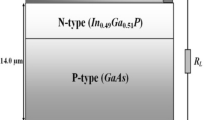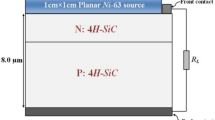Abstract
Alphavoltaic nuclear batteries are promising long-life power sources. Their effective performance is strongly dependent on the design of the device structure and the used semiconductors as well as on the appropriate radiation source involved in the power conversion process. Currently, semiconductor heterojunction structures are promising in improving the efficiency of nuclear micro-batteries. In this study, we designed and evaluated a micro-power alphavoltaic nuclear battery consisting of an In0.49Ga0.51P/GaAs alphavoltaic heterostructure using a lab-made software. The device active area is 1 cm2 and the assumed energy source is Thorium-228 (Th228) which emits alpha particles with an average kinetic energy of 5.423 MeV. We used a comprehensive analytical model to extract the energy conversion efficiency of the cell by simulating its current density–voltage J(V) and output electric power P(V) curves. Our analysis took into account the reflection of the incident alpha particles from the front surface, the ohmic losses, the limits of the space charge region, and the metallurgical border effects. To optimize the device performance, we investigated a wide range of doping concentrations and surface recombination velocities in both the back and front regions while also assuming different values of the radioisotope apparent activity density. Under irradiation by a 3.2 mCi/cm2 Th228 source, the energy conversion efficiency of the cell is 8.83%, while the maximum output power density is 18.15 µW/cm2. The obtained results are very encouraging showing that the use of Th228 coupled with an appropriate In0.49Ga0.51P/GaAs heterojunction could be a suitable solution for designing alphavoltaic batteries with a useful output power.








Similar content being viewed by others
Data availability
The data that support the findings of this study are available from the corresponding author, [F Bouzid], upon reasonable request.
References
M. Prelas, M. Boraas, F. Aguilar, J.D. Seelig, M.T. Tchouaso, D. Wisniewski, Lecture Notes in Energy. Nuclear Batteries and Radioisotopes, 56th edn. (Springer, 2016)
P. Rappaport, The electron-voltaic effect in p–n junctions induced by beta particle bombardment. Phys. Rev. 93, 246 (1953)
A. Krasnov, S. Legotin, K. Kuzmina, N. Ershova, B. Rogozev, A nuclear battery based on silicon p-i-n structures with electroplating 63Ni layer. Nucl. Eng. Technol. 51, 1978–1982 (2019)
J. Dixon, A. Rajan, S. Bohlemann, D. Coso, A.D. Upadhyaya, A. Rohatgi, S. Chu, A. Majumdar, S. Yee, Evaluation of a silicon 90Sr betavoltaic power source. Sci. Rep. 6, 38182 (2016). https://doi.org/10.1038/srep38182
F. Bouzid, F. Pezzimenti, L. Dehimi, Modelling and performance analysis of a GaN-based n/p junction betavoltaic cell. Nuclear Inst. Methods Phys. Res. 969, 164103 (2020)
R.K. Yürük, H. Tütüncüler, Theoretical investigation of high-efficiency GaN–Si heterojunction betavoltaic battery. Can. J. Phys. 97(9), 1031–1038 (2019). https://doi.org/10.1139/cjp-2018-0579
C.E. Munson, Q. Gaimard, K. Merghem, S. Sundaram, D.J. Rogers, J. de Sanoit, P.L. Voss, A. Ramdane, J.P. Salvestrini, A. Ougazzaden, Modeling, design, fabrication and experimentation of a GaN-based 63Ni betavoltaic battery. J. Phys. D 51, 035101 (2018). https://doi.org/10.1088/1361-6463/aa9e41
F. Bouzid, M.A. Saeed, R. Carotenuto, F. Pezzimenti, Design considerations on 4H-SiC-based p–n junction betavoltaic cells. Appl. Phys. A 128, 234 (2022). https://doi.org/10.1007/s00339-022-05374-7
Y.M. Liu, J.B. Lu, X. Xu et al., A 4H-SiC betavoltaic battery based on a 63Ni source. Nucl. Sci. Tech. 29, 168 (2018)
A.A. Svintsov, A.A. Krasnov, M.A. Polikarpov, A.Y. Polyakov, E.B. Yakimov, Betavoltaic battery performance: comparison of modeling and experiment. Appl. Radiat. Isot. 137, 184–189 (2018)
S. Theirrattanakul, M. Prelas, A methodology for efficiency optimization of betavoltaic cell design using anisotropic planar source having an energy dependent beta particle distribution. Appl. Radiat. Isot. 127, 41–46 (2017)
T.R. Alam, M.G. Spencer, M.A. Prelas, M.A. Pierson, Design and optimization of radioisotope sources for betavoltaic batteries. Int. J. Energy Res. 42, 2564–2573 (2018). https://doi.org/10.1002/er.4053
L. Zhang, H.L. Cheng, X.C. Hu, X.B. Xu, Model and optimal design of 147Pm SiC-based betavoltaic cell. Superlattices Microstruct. (2018). https://doi.org/10.1016/j.spmi.2018.01.007
V. Bormashov, S. Troschiev, A. Volkov, S. Tarelkin, E. Korostylev, A. Golovanov, M. Kuznetsov, D. Teteruk, N. Kornilov, S. Terentiev, S. Buga, V. Blank, Development of nuclear microbattery prototype based on Schottky barrier diamond diodes. Phys. Status Solidi A 212(11), 2539–2547 (2015). https://doi.org/10.1002/pssa.201532214
Y.-M. Liu, L. Jing-Bin, X.X. Xiao-Yi Li, R. He, R.-Z. Zheng, G.-D. Wei, Theoretical prediction of diamond betavoltaic batteries performance using 63Ni. Chin. Phys. Lett. 35(7), 072301 (2018). https://doi.org/10.1088/0256-307X/35/7/072301
M.G. Spencer, T. Alam, High power direct energy conversion by nuclear batteries. Appl. Phys. Rev. 6, 031305 (2019). https://doi.org/10.1063/1.5123163
V.P. Khvostikov, V.S. Kalinovskiy, S.V. Sorokina, O.A. Khvostikova, V.M. Andreev, Tritium power supply sources based on AlGaAs/GaAs heterostructures. Tech. Phys. Lett. 45(12), 1197–1199 (2019)
V.P. Khvostikov, V.S. Kalinovskiy, S.V. Sorokina, M.Z. Shvarts, N.S. Potapovich, O.A. Khvostikova, A.S. Vlasov, V.M. Andreev, AlGaAs/GaAs photovoltaic converters of tritium radioluminescent-lamp radiation. Semiconductors 52(13), 1754–1757 (2018)
V.M. Andreev, A.G. Kavetskf, V.S. Kalinovsky, V.P. Khvostikov, V.R. Larionov, V.D. Rumyantsev, M.Z. Shvarts, E.V. Yakimova, V.A. Ustinov, Tritium-powered betacells based on AlxGa1-xAs. IEEE Photovolt. Specialists Conf. (2000). https://doi.org/10.1109/PVSC.2000.916117
F. Bouzid, S. Dehimi, M. Hadjab, M.A. Saeed, F. Pezzimenti, Performance prediction of AlGaAs/GaAs betavoltaic cells irradiated by nickel-63 radioisotope. Physica B: Phys. of Conden. Matter. 607, 412850 (2021)
S. Butera, G. Lioliou, A.M. Barnett, Temperature effects on gallium arsenide 63Ni betavoltaic cell. Appl. Radiat. Isot. 125, 42–47 (2017)
A. Waris, Y. Kusumawati, A.S. Alfarobi, I.K. Aji, K. Basar, Preliminary design of betavoltaic battery using Co-60 and Pm-147 with GaAs substrate. AIP Conf. Proc. 1719, 030053 (2016). https://doi.org/10.1063/1.4943748
S. Butera, M.D.C. Whitaker, A.B. Krysa, A.M. Barnett, Investigation of a temperature tolerant InGaP (GaInP) converter layer for a 63Ni betavoltaic cell. J. Phys. D 50, 345101 (2017)
C.D. Cress, B.J. Landi, R.P. Raffaelle, InGaP alpha voltaic batteries: synthesis, modeling, and radiation tolerance. J. Appl. Phys. 100(11), 114519 (2006)
C.D. Cress, B.J. Landi, R.P. Raffaelle, Modeling laterally-contacted nipi-diode radioisotope batteries. IEEE Trans. Nucl. Sci. 55(3), 1736 (2008)
D.Y. Qiao, X.J. Chen, Y. Ren, W.Z. Yuan, A micro nuclear battery based on SiC Schottky barrier diode. J. Microelectromech. Syst. 20, 685–690 (2011)
F. Bouzid, F. Pezzimenti, L. Dehimi, F.G. Della Corte, M. Hadjab, A.H. Larbi, Analytical modeling of dual-junction tandem solar cells based on an InGaP/GaAs heterojunction stacked on a Ge substrate. J. Electron. Mater. 48, 4107 (2019)
W. Duan, A. Lambertz, K. Bittkau, D. Qiu, K. Qiu, U. Rau, K. Ding, A route towards high-efficiency silicon heterojunction solar cells. Prog. Photovolt. Res. Appl. 30, 384–392 (2022)
Y. Liu, Y. Li, Y. Wu, G. Yang, L. Mazzarella, P. Procel-Moya, A.C. Tamboli, K. Weber, M. Boccard, O. Isabella, X. Yang, B. Sun, High-efficiency silicon heterojunction solar cells: materials, devices and applications. Mater. Sci. Eng. R. Rep. 142, 100579 (2020)
C.F. Kamdem, A.T. Ngoupo, F.X.A. Abega, A.M.N. Abena, J.-M.B. Ndjaka, Design and performance enhancement of a GaAs-based homojunction solar cell using Ga0.5In0.5P as a back surface field (BSF): a simulation approach. Int. J. Photoenergy 2023, 6204891 (2023). https://doi.org/10.1155/2023/6204891
J. Xu, M. Guo, M. Lu, H. He, G. Yang, J. Xu, Effect of alpha-particle irradiation on InGaP/GaAs/Ge triple-junction solar cells. Materials 11, 944 (2018). https://doi.org/10.3390/ma11060944
Y. Okuno, S. Okuda, T. Oka, S. Kawakita, M. Imaizumi, Performance degradation of InGaP solar cells due to 70 keV electron irradiation. Jpn. J. Appl. Phys. 56, 081203 (2017). https://doi.org/10.7567/JJAP.56.081203
International Atomic Energy Agency, Thorium fuel cycle. Potential benefits and challenges, IAEA-TECDOC-1450, Vienna (2005).
B. Kınacı, Y. Özen, T. Asar, S.Ş Çetin, T. Memmedli, M. Kasap, S. Özçelikt, Study on growth and characterizations of GaxIn1−xP/GaAs solar cell structure. J. Mater. Sci. 24, 3269–3274 (2013). https://doi.org/10.1007/s10854-013-1242-y
S.M. Sze, K.K. Ng, Physics of Semiconductor Devices, 3rd edn. (Interscience, New York, 2006)
https://www.ioffe.ru/SVA/NSM/Semicond/GaAs/basic.html. Accessed 28 June 2023
https://www.ioffe.ru/SVA/NSM/Semicond/GaInP/basic.html. Accessed 28 June 2023
S. Keith, J.R. Doyle, C. Harper et al., Toxicological Profile for Radon (Agency for Toxic Substances and Disease Registry (US), Atlanta, 2012)
J. Magill, G. Pfennig, J. Galy, Karlsruher Nuklidkarte, 7 (European Commission Joint Research Centre Institute for Transuranium Elements, 2006)
K.E. Bower, Y.A. Barbanel, Y.G. Shreter, G.W. Bohnert, Polymers, Phosphors, and Voltaics for Radioisotope Microbatteries, 1st edn. (CRC Press, New York, 2002)
A.W. Haas, J.R. Wilcox, J.L. Gray, R.J. Schwartz, Design of a GaInP/GaAs tandem solar cell for maximum daily, monthly, and yearly energy output. J. Photon. Energy. 1, 018001 (2011)
M.E. Levinshtein, S.L. Rumyantsev, M. Shur, Handbook Series on Semiconductor Parameters, 1st edn. (World Scientific, London, 1996), pp.77–103
A. Dargys, J. Kundrotas, Handbook on Physical Properties of Ge, Si, GaAs and InP, Vilnius (Science and Encyclopedia Publishers, 1994)
M.Y. Ghannam, A.S. Al Omar, N. Posthuma, G. Flammand, J. Poortmans, Optimization of the triple junction In0.5Ga0.5P/GaAs/Ge monolithic tandem cell aimed for terrestrial applications using an experimentally verified analytical model. Kuwait J. Sci. Eng. 31(2), 203–234 (2004)
S.C. Jain, D.J. Roulston, A simple expression for band gap narrowing (BGN) in heavily doped Si, Ge, GaAs and GexSi1-x strained layers. Solid-State Electron. 34(5), 453–465 (1991)
D.M. Caughey, R.E. Thomas, Carrier mobilities in silicon empirically related to doping and field. Proc. IEEE 55, 2192 (1967)
M. Sotoodeh, A.H. Khalid, A.A. Rezazadeh, Empirical low-field mobility model for III–V compounds applicable in device simulation codes. J. Appl. Phys. 87, 2890 (2000)
T.R. Alam, M.A. Pierson, Principles of betavoltaic battery design. J. Energy Power Sources 3(1), 11–41 (2016)
Y. Da, Y. Xuan, Role of surface recombination in affecting the efficiency of nanostructured thin-film solar cells. Opt. Express 21(S6), 1065–1077 (2013). https://doi.org/10.1364/OE.21.0A1065
F. Saeed, T.U. Rehman, A. Zohaib, A. Farid, M.H. Khan, M.A. Khan, H.A. Tauqeer, A. Idrees, Unveiling surface recombination velocity influence on the device characteristics for the formamidinium perovskite solar cell. Eng. Proc. 20(4), 1–6 (2022). https://doi.org/10.3390/engproc2022020004
T.P. Weiss, B. Bissig, T. Feurer, R. Carron, S. Buecheler, A.N. Tiwari, Bulk and surface recombination properties in thin film semiconductors with different surface treatments from time resolved photoluminescence measurements. Sci. Rep. 9, 5385 (2019). https://doi.org/10.1038/s41598-01941716-x
K. Ali, H.M. Khan, M. Anmol, I.A. Ahmad, W.A. Farooq, B.A. Al-Asbahi, S.M. Qaid, H.M. Ghaithan, Effect of surface recombination velocity (SRV) on the efficiency of silicon solar cell. J. Optoelectron. Adv. Mater. 22(5–6), 251–255 (2020)
F. Bouzid, Prediction of the conversion efficiency of a GaSb thermophotovoltaic converter heated by radioisotope source. Int. J. Renew. Energy Res. 3(3), 717–724 (2013)
F. Bouzid, N. Benaziez, Modeling of InGaN/GaAs photovoltaic tandem with GaAs/AlAs bragg mirror rear surface reflector. Int. J. Renew. Energy Res. 4(3), 757–764 (2014)
Author information
Authors and Affiliations
Corresponding author
Additional information
Publisher's Note
Springer Nature remains neutral with regard to jurisdictional claims in published maps and institutional affiliations.
Rights and permissions
Springer Nature or its licensor (e.g. a society or other partner) holds exclusive rights to this article under a publishing agreement with the author(s) or other rightsholder(s); author self-archiving of the accepted manuscript version of this article is solely governed by the terms of such publishing agreement and applicable law.
About this article
Cite this article
Bouzid, F., Kayahan, E. & Pezzimenti, F. Thorium-228 as emitting source for InGaP/GaAs-based heterojunction alphavoltaic cells. Appl. Phys. A 129, 554 (2023). https://doi.org/10.1007/s00339-023-06829-1
Received:
Accepted:
Published:
DOI: https://doi.org/10.1007/s00339-023-06829-1




